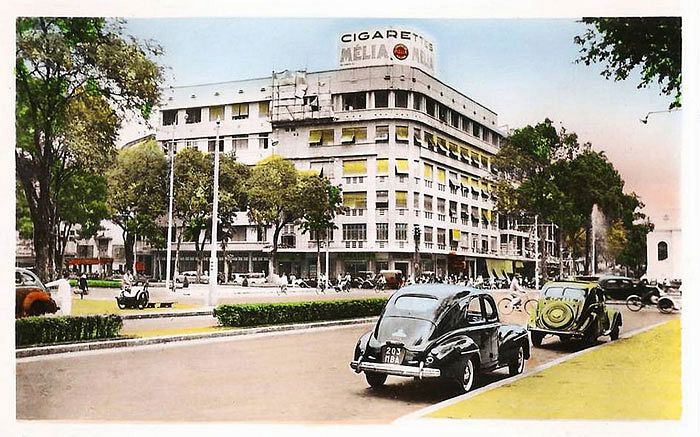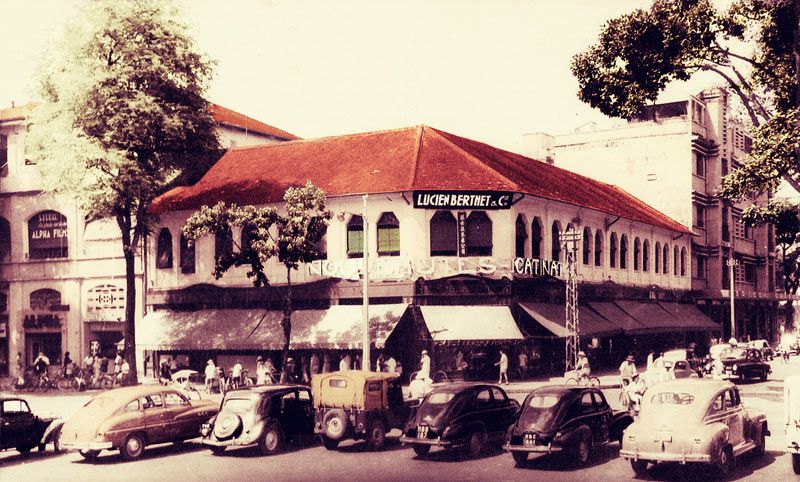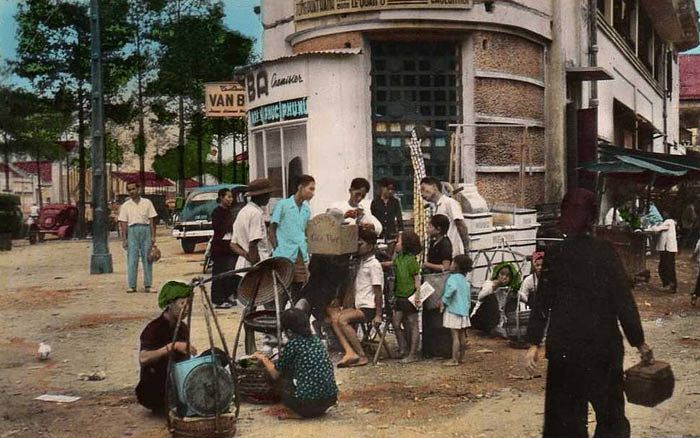Located on a prime site in one of Hồ Chí Minh City’s numerous “đất vàng” (gold land) areas and already earmarked for redevelopment, the headquarters of the Department of Culture, Sports and Tourism at 164 Đồng Khởi has a sinister past.
The 164 Đồng Khởi complex stands on a site which in the 1860s was part of the place Centrale or place de l’Horloge (clock square), an open space next to the first French governor’s palace where most early French government buildings were located.

The main entrance to 164 Đồng Khởi.
By the 1870s, the land on which the building now sits was occupied by the first Saigon Post Office. The mysterious postcard of an unknown building labelled “Saigon – Hotel des postes,” long thought to be a mistake by the photographic studio, is most likely to be the “Poste aux lettres” which appears on an 1878 map of Saigon.

The “Saigon – Hotel des postes” featured in this old postcard was probably the first city post office, the “Poste aux lettres” marked (9) on the 1878 map of Saigon.
After the inauguration of the second (current) Post Office building in 1891, the site was redeveloped into three separate properties (162, 164 and 166 rue Catinat). In the 1890s, two of these – 164 and 166 – were acquired by the colonial Treasury (then headquartered across the road on the site of the modern Metropolitan Building) and subsequently became home to various financial departments, including the Recette locale and later the Trésor local.
However, by 1910, the Commissariat central de Police had taken up residence next door at 162 rue Catinat. In 1917, this police headquarters expanded into 164 rue Catinat, where it subsequently became the Direction de la Police et de la Sûreté. In 1933, the last accountants were moved out of 166 rue Catinat and the entire compound (162, 164 and 166) was rebuilt in its current form as the Sûreté headquarters at 164 rue Catinat.
Known in Vietnamese as Bót Catinat, it developed a fearsome reputation as a place of cruelty; it is said that many of those imprisoned in its cells were tortured before being transferred to the longer-term accommodation of the Maison centrale (Central Prison) on rue de La Grandière, now Lý Tự Trọng street. Located so close to the Cathedral, Bót Catinat was described by unfortunate inmates as “Hell next to heaven.”
Related Articles:
- The Lost History of Germans in Saigon
- Old Saigon Building of the Week: Maison du Combattant
A plaque outside the main entrance of the building informs us (in Vietnamese) that immediately after the August Revolution, the Việt Minh flag flew over Bót Catinat from 26 August until 23 September 1945, when, with British support, the French reoccupied Sài Gòn’s public buildings. Thereafter, Bót Catinat resumed its original function.
In the early 1950s, the Sûreté headquarters appeared in British writer Graham Greene’s novel The Quiet American as the workplace of Inspector Vigot, the French detective responsible for investigating the death of American agent Pyle. Like Greene himself when he lived in Saigon, the novel’s anti-hero Thomas Fowler took a daily constitutional up rue Catinat, “to where the hideous pink cathedral blocked the way.” On one such walk, Fowler describes “the dreary wall of the Vietnamese Sûreté that seemed to smell of urine and injustice.”

Its “dreary wall... seemed to smell of urine and injustice.” (Graham Greene, The Quiet American) - the Direction de la Police et de la Sûreté, pictured in 1950.
After the departure of the French in 1954, 164 rue Catinat was refurbished and in 1955 it was transformed into the South Vietnamese Interior Ministry (Bộ Nội vụ) at 164 Tự Do.

The South Vietnamese Interior Ministry (Bộ Nội vụ) at 164 Tự Do, pictured in 1965.”
Since Reunification, it has served as the headquarters of the Department of Culture and Information (1977) and subsequently the Department of Culture, Information, Sport and Tourism (1990) at 164 Đồng Khởi. The building still retains its old basement prison cells, although it has never been opened to the public as a historic monument.
According to a recent Dân trí newspaper article, the block on which 164 Đồng Khởi stands – a 9,700m² site enclosed by Đồng Khởi, Nguyễn Du and Lý Tự Trọng streets and bordering the Trần Đại Nghĩa Specialist High School – is to be redeveloped to accommodate “services, culture, luxury hotels, finance offices, exhibition areas.” New buildings on the site will be limited to a height of 100m (approximately 25 storeys), with a four-storey limit on the Nguyễn Du-Đồng Khởi junction opposite the Cathedral.
Dân trí newspaper also reports that the decision not to conserve the old Bót Catinat building was made in accordance with the recommendations of its current occupant, the Department of Culture, Sports and Tourism, which nonetheless suggested that efforts be made to preserve “a few artefacts, if there are any,” to build a model of Bót Catinat and to create a plaque describing its history for display somewhere in the area bordering Nguyễn Du street.
Tim Doling is the author of the forthcoming book of walking tours entitled Exploring Hồ Chí Minh City (Nhà Xuất Bản Thế Giới, Hà Nội, 2014) and also conducts 4-hour Heritage Tours of Historic Saigon and Cholon. For more information about Saigon history and Tim's tours visit his website, www.historicvietnam.com.














